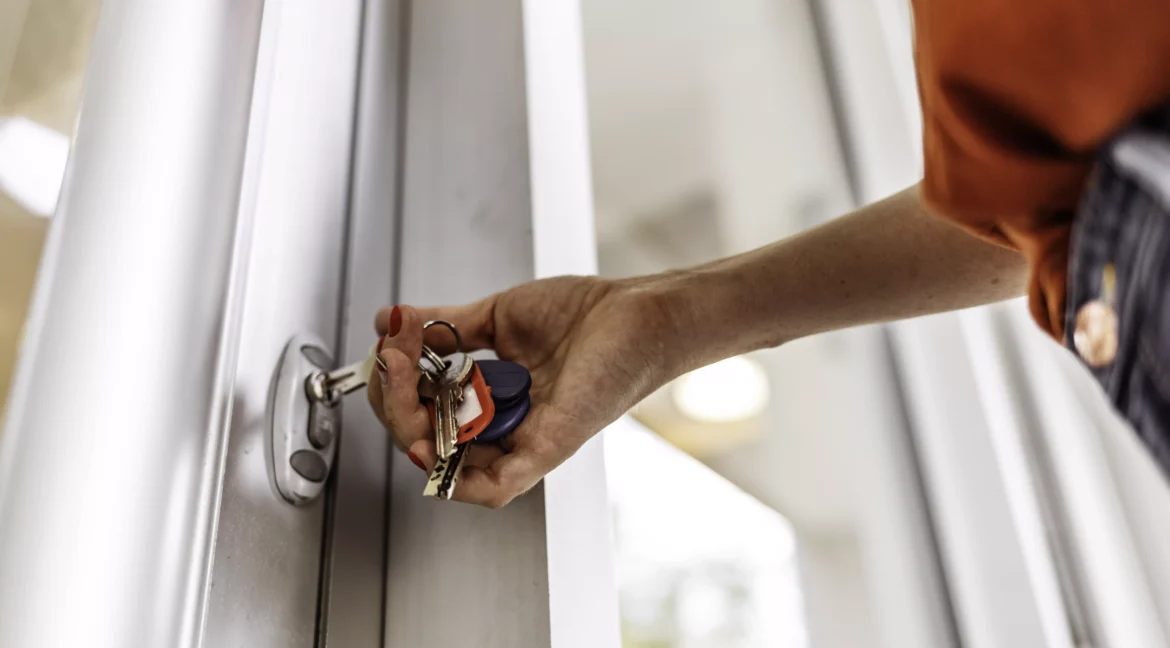Here’s what experts say you need to do to make your transition into your new home a success.
Published on October 4, 2023
Welcome to your new home! Your mind is likely racing with ideas for living room decor, kitchen renovations, and all the friends and family you’ll soon host in your new space.
“Moving into a new home can be an exciting and stressful time,” says Tom Mallette, broker/owner at Better Homes and Gardens Real Estate Heritage. “It is a wise move to step back, take a breath, and prepare the home before you just move right in.”
So before you get too carried away unpacking and settling in, these experts have some tips on what to do to your space first to make the transition smooth.
:strip_icc():format(webp)/locking-door-with-a-key--1265282594-c20140c5e12f428f95c817a61621ae44.jpg)
Be Safe and Sanitary
Sleeping in your new home for the first time can be a bit unsettling. The new noises are unfamiliar, the neighborhood might be foreign to you, and chances are you won’t feel truly at home for some time. Allay any security fears by tackling some standard safety practices right up front.
Change Your Locks
You might get a set of keys for your new place when you sign the closing docs, but you never know how many other people out there have their own copies: think relatives of the former owners, pet sitters, and even repairmen.
The first step will be to replace those locks and keys to make sure you’re the only ones who can get into the house.
“We also suggest testing all windows and gates to make sure they open, close, and lock properly,” says Marissa Hagmeyer, cofounder of the NEAT Method for luxury home organizing.
Don’t forget to change the garage code, too. Karen Baum, broker associate at BHG Real Estate Kansas City Homes, says it’s one of the most overlooked tasks.
“Some people are intimidated by this task, but it’s relatively simple and can be done in a few minutes,” she says. “Look up the model of the garage keypad and find the directions online. Setting a new code should not include the address of the house or an easily guessed number.”
And while you’re locking doors, lock the windows, too.
Install Home Security Systems
Similar to the suggestion for new locks, you’ll want to set up your security system sooner rather than later. Spend an hour or so installing cameras aimed at the entry points and any important assets in the yard including your garage, shed, and vehicles.
It might seem like a pricey task to pay for all new locks and security systems, but there could be help there, too.
“In most cases, your homeowner’s insurance will also issue you a credit, a win-win,” says Ashley J. Farrell of The Corcoran Group in Westhampton Beach, New York, and Palm Beach, Florida.
Check Your Smoke Alarm Batteries
Your home inspection likely covered smoke alarms, but it’s always smart to test those batteries on day one in your new house. To be super safe, swap the batteries out for fresh ones regardless of whether they pass the test.
“In addition to replacing locks, take a moment to inspect any alarm systems and smoke and carbon monoxide detectors,” Hagmeyer says. “Check that natural gas and water is running and that there are no leaks.”
Another check should be for radon gas, although this is usually something that comes up during your home inspection, Mallette says.
Swap Toilet Seats
It might look clean, but the toilet seat in your bathroom has likely been around for years. Want a super sanitary start? Swap it for a fresh one. It’s a quick DIY you can do on day one.
Remove Dryer Lint
Before you put laundry in the dryer, it’s smart to check for remnant lint, which can cause fires. You can do this yourself or plan to hire a pro to come in on week one to clean the traps and start fresh.
“Allowing a dryer vent to build up with lint is a serious fire hazard,” says Farrell.
Locate the Nearest Hospital
If you’re new in town, you’ll want to have a list of important locations handy, including your local hospital and pharmacy. Do a little bit of internet sleuthing and save the location. While you’re at it, it’s great to have numbers for fire, EMS, and police handy, depending on where you live.
“If you are moving to a new area, it’s good practice to familiarize yourself with your surroundings,” Farrell says. “In my career I’ve had the pleasure of working with numerous doctors. One item that always comes up is where the nearest hospital is located. It’s such a simple question, yet so important. In an emergency, coordinating directions is the last thing you want to worry about.”
While you’re at it, get your bearings for local health providers in general.
“Setting up new health care providers can prove to be one of the toughest tasks with moving,“ Mallette says. “Before your move, do your research for new doctors, dentist, specialists, etc. Once you choose the new providers, work to get your medical records moved so your new provider has the full picture of your health history.“
Before You Move Furniture In…
Rarely is your home totally empty, so it’s great to take advantage of the fact that most rooms, walls, and floors are bare right after you’ve officially become the house’s owner. Think about tackling a few projects and deep cleans before unloading that moving truck.
Hire Professional Cleaners
Sure, you can give the place a once over yourself, but this is also a perfect opportunity for a deep clean while your new home is empty.
“Most sellers will do their best to get the home cleaned after or while they are moving out, while some sellers will hire a professional cleaner to do a nice deep clean,” Mallette says. “Unfortunately, the best intentions may not be satisfactory to you.”
To make sure it’s done right, hire a pro.
“Moving is so overwhelming, and you’re likely already cleaning your current home, so having someone take care of the new home is a luxury that’s well worth it,” says NEAT Method’s other co-founder, Ashley Murphy.
Professional cleaners can also pay special attention to certain areas in the home where dirt, grime, and germs build up.
“High-traffic areas such as door or cabinet handles, faucets, light switches, keypads, and banisters will typically benefit from a deep clean and disinfecting,” Hagmeyer says. “We would also suggest washing windows inside and out and dusting all light fixtures, as they tend to collect a lot of dirt that is not always visible.”
Mallette suggests adding the following hard-to-see places to your list: the tops of ceiling fans, window ledges above eye level, the dreaded back of the toilet, and the tops of cabinets.
“As a real estate agent, I know how sellers can ‘fake’ clean a home when they move out,” Baum says. “I want to make sure my new home is genuinely clean so I can relax and enjoy my new space.”
Repaint and Start Projects
It might seem like your home’s facelift can wait, but having things like new paint and flooring installed when the home is empty is actually a great idea.
“It will make the vendors’ jobs so much easier (and may save you money!) if they do not have to move and work around furnishings,” Mallette says.
To get things handled smoothly, try scheduling for these projects as you prepare to move.
“Plan ahead to take possession of the house before you have to move, giving yourself a week or so to knock out those painting projects,” Baum suggests.
Stay Warm
There are a few other items to attend to when moving in, including servicing any chimneys, furnaces, or boilers.
Farrell suggests scheduling a chimney cleaning and servicing off the bat and getting an annual inspection in the books from there.
“The same holds true for your furnace or oil burner. If the previous owners recently had the boiler serviced, make a note to do the same the following year,” she says. “Speaking of fuel, if you live in a colder climate, ensure your oil/propane tanks are full. You’ll avoid the nightmare, which is freezing or—God-forbid—burst pipes.”
See about scheduling automatic fuel delivery, too, so you’re never left out in the cold.
Do Your Paperwork
So much of moving involves the physical labor of packing, driving, unloading, and unpacking, but don’t forget all the paperwork, too. It’s a different kind of labor, but if you plan ahead, you can make the work a breeze.
Register Your Pet
While you’re registering your vehicles, don’t forget Fido. Many local communities require that dogs and cats are registered with their vaccination history as soon as possible.
It’s also good to be intentional about introducing your pet to the home.
“If you can, visit the new home with your pet a few times before moving in. Give them time to explore the yard and interior of the home so they can get used to the new smells. On moving day, board them locally to avoid additional stressors,” Murphy says. “Once the movers are gone and priority spaces are unpacked, bring them to the new home. Place their food bowls and bed where they will permanently live right away, to avoid more changes down the road.”
Forward Your Mail
And don’t forget your postage. You can set your mail forwarding in advance by scheduling it through the United States Postal Service.
“We suggest forwarding your mail about one week before your move-in date,” Hagmeyer says. “This will ensure your old mailbox is empty on moving day and avoid important pieces of mail from getting lost in the shuffle. Then, make sure to set up your mail drop-zone right after move-in so you can immediately begin sorting mail.”
Make Packing Easy
Packing and unpacking is one of the most time-consuming parts of moving. Here are some ways you can make the process easier.
Downsize and Declutter
Moving is one of those rare times in your life when you’re forced to take a full inventory of all the things you own. Take advantage by paring down your belongings.
“Our number one tip for an organized move is getting rid of items you no longer need or want before packing,” Hagmeyer says. “It’s just not worth the time and resources required to move items you will likely end up donating anyway. Lastly, don’t forget that hiring help is always an option. We offer unpacking and organizing services in locations across the US and Canada so you can settle into your new home quickly and neatly.”
Label Your Items by Room
As you pack, label boxes by room and get detailed with descriptions of key items in each. Then, prep your home for move in.
“Add signs to the doors or doorway of each room in the house, stating what is it to make it easier for movers to locate where each box or furniture piece belongs,” Murphy suggests. “This will help ensure no items are misplaced throughout the home.”
Unpack Quickly
Moving companies will often charge to unpack your items. If that’s an option, go for it. Otherwise, Mallette suggests unpacking yourself sooner rather than later.
“The worst part of moving for most is the packing process—until you have to unpack,” Mallette says. “Many have made a move where a few years later, there are still a few boxes stored that were never unpacked. You may be starting a new job, etc., so hiring a crew may be the way to go, but if you prefer to unpack yourself, get it knocked out.”
Source: Better Homes and Gardens

